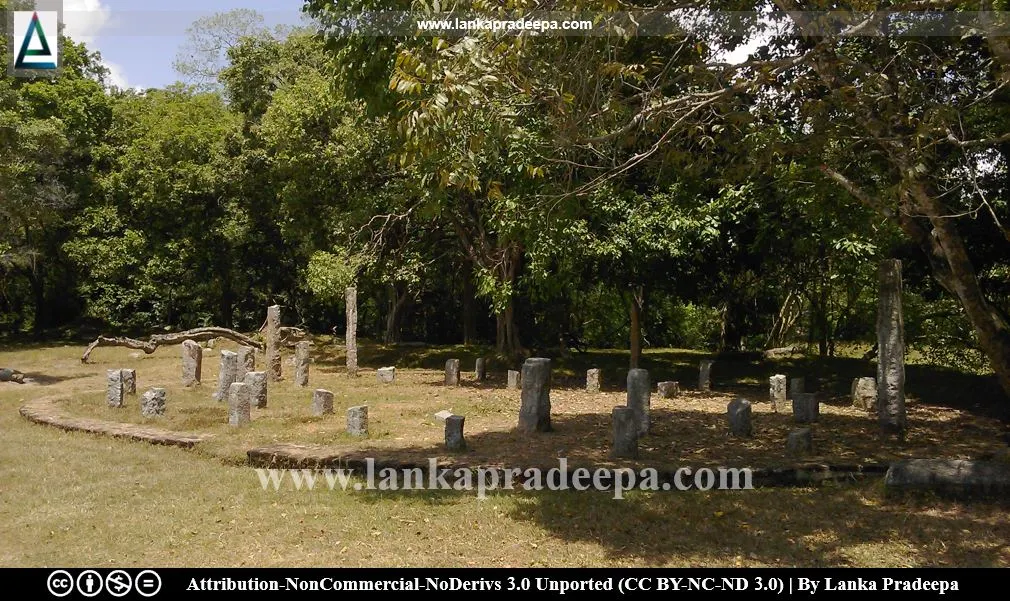
|
Haththikuchchi Viharaya Ruins |
Haththikuchchi Viharaya (Sinhala: හත්ථිකුච්චි විහාරය) is an ancient Buddhist monastery complex situated in Rajanganaya, Kurunegala District, Sri Lanka.
History
The ruins of the Haththikuchchi ancient monastery complex extends in an area of about 300 acres (Anuradha & Kumari, 2015). A large number of rock and cave inscriptions dating from the 3rd century B.C. to 10th century A.D. are found at the site (Anuradha & Kumari, 2015). Of them, some inscriptions belong to the Vaharala-sellipi type and they record about the freeing of slaves from their compulsory services.
On the Haththikuchchi rock and its base, more than fifty rock inscriptions dating from 2nd to 9th centuries A.D. are found. Among them, a 2nd century A.D. inscription reveals the old name of this site as Atiku(ci)ya Vihara and therefore the site is identified by archaeologists with the ancient Haththikuchchi Viharaya, a well-known monastery mentioned in old Pali Commentaries (Nicholas, 1963).
Haththikuchchi Vihara Rock InscriptionS

Period: 2nd century A.D.
Script: Later Brahmi
Language: Old Sinhala
Content: This inscription records the donations made for the maintenance of the chapter house at Hatthikuchchi Vihara
Reference: The information board at the site by the Director-General of Archaeology.
According to early written sources, several kings have involved in the restoration or development of this temple. King Aggabodhi I (571-604 A.D.) is said to have established a Pasada in the temple and so did King Aggabodhi VII [(772-777 A.D.) Nicholas, 1963]. King Aggabodhi IX (831-833 A.D.) rebuilt a ruined Pasada at the temple (Nicholas, 1963). Also the Buddhist monk Buddhaghosa mentions that there was a cave suited for the meditation on the Haththikuchchi-pabbhara (Nicholas, 1963). The cave mentioned by Buddhaghosa is said to be the summit cave on the southern hill of the present Haththikuchchi temple (Nicholas, 1963).
King Sirisamghabodhi
Haththikuchchi is considered by many as the place where King Sirisamghabodhi (252–254 A.D.) offered his own head to a peasant (Anuradha & Kumari, 2015). However, it is traditionally accepted that this incident happened at Attanagalla Raja Maha Viharaya in Gampaha District.
Archaeological Museum
A small site museum of the Archaeological Department is situated near the entrance of the Haththikuchchi Viharaya. The museum is used to illustrate the historical value of Haththikuchchi Viharaya by displaying the antiquities recovered from the site.
An Archaeological Reserve
The land plot named Rajanganaya Puravidya Sthanaya (A 256: consist of 28 acres, 2 roods, 29 perches) situated in Rajangane, Palu-gankadawala and Galkadawala villages is an archaeological reserve, declared by a government Gazette notification published on 27 January 1939.





Related Posts
Read Also
References
Books, Government Gazette Notifications, Journal Articles
1) Anuradha, R.K.S.; Kumari, A.S., 2015. Pauranika Sthana Saha Smaraka: Kurunegala Distrikkaya (In Sinhala). Department of Archaeology (Sri Lanka). ISBN: 955-9159-37-2. p.75.
2) Nicholas, C. W., 1963. Historical topography of ancient and medieval Ceylon. Journal of the Ceylon Branch of the Royal Asiatic Society, New Series (Vol VI). Special Number: Colombo. Royal Asiatic Society (Ceylon Branch). p.93.
3) The Gazette notification. no: 8428. 27 January 1939.

